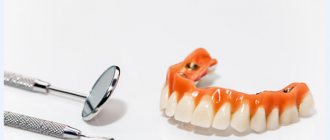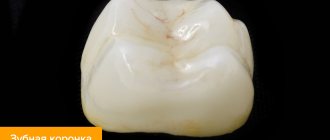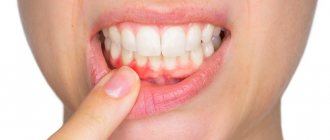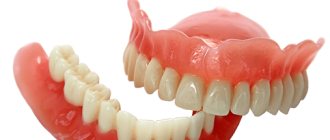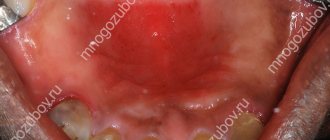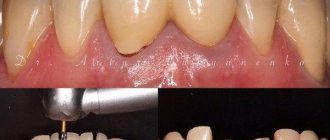Prosthetics completed. Behind were casts and fittings. All you have to do is get used to your new jaw. It turns out it's not that simple. Any removable structure is perceived by the body as a foreign body. It takes time for him to begin to perceive the removable jaw as his own. How to get used to removable dentures?
The dentist must warn the patient about what kind of reaction there may be to the prosthesis:
- increased salivation;
- attacks of nausea;
- urge to vomit;
- tension in the cheeks and lips;
- violation of diction;
- difficulty chewing.
All attention is focused on the foreign body in the mouth. It is difficult to fight the urge to remove the prosthesis.
In some cases, atypical reactions to prosthetics are observed. You should immediately consult a doctor if:
- there is redness and swelling in places of contact with the prosthesis;
- wounds and ulcerations appeared on the gums;
- painful to swallow;
- burning sensation in the mouth.
Signs of an allergy to a denture
These could be signs of an allergic reaction
on materials of construction.
Dry mouth or increased salivation
A feeling of dryness or, on the contrary, increased salivation occurs due to the adaptation of the mucous membranes to a foreign body. If the design is made correctly, the discomfort quickly passes. If your mouth is dry, you should drink water more often and rinse, but do not use alcohol solutions. It is worth limiting the consumption of tea, coffee, and at least temporarily giving up smoking. You need to get rid of dryness quickly, otherwise your gums will be injured.
Excessive salivation is a reaction to a foreign body in the mouth, to constant contact with the mucous membrane. It goes away on its own in a few days. You can simplify the adaptation process for the mucous membrane by rinsing with decoctions of chamomile, oak bark or sage, or solutions recommended by your doctor.
How long does it take to get used to dentures?
Dentists distinguish 3 phases of adaptation:
- The first phase is irritation
. And although doctors mean irritation of nerve receptors, the name of the phase perfectly conveys the patient’s condition. Irritation and the desire to pull out a foreign object are the 2 main feelings of the first day. A psychological attitude and any, preferably enjoyable, activity helps to overcome them. - The second phase is partial braking
.
Then comes the reward for patience and perseverance. Restoration still interferes, but not as much. Salivation decreases, nausea goes away. Cheeks and lips are less tense. Chewing function is restored. This phase takes about 5 days
. - The third phase is complete braking
. Diction is normalized, chewing no longer causes discomfort, and there is no sensation of a foreign body. The patient experiences discomfort when the jaw is not in place. Adaptation is complete.
On average, getting used to dentures takes 10-30 days.
.
Problems with diction
After prosthetics, there is less space in the mouth, which is why the patient may have problems with diction at first: the tongue does not have enough free space, sounds are distorted. To cope with this faster, you will need training. To do this, you can read aloud, pronounce individual complex sounds, and do tongue exercises. The more actively the tongue “works” immediately after prosthetics, the faster the adaptation will take place and normal diction will be restored. When getting used to speaking correctly, you need to make sure that when pronouncing sounds, saliva does not fly from your mouth. A good workout would be tongue twisters that are spoken slowly, making sure that the pronunciation and articulation are correct.
Eating
Chewing skills with a newly installed denture need to be developed gradually. This does not mean that you need to switch to broths, purees and cereals. On the contrary, you need training with a gradual increase in load. The hardness of the products is increased gradually. It is better to start eating vegetables and fruits in small pieces, chewing them thoroughly. They get used to biting food in the same way - gradually, starting with softer foods and moving on to hard foods. You need to chew and bite carefully: it is important not to damage or injure the gums, and to control the load on it.
After installing a removable denture, the patient may feel that food is deprived of its usual taste, it has become less pronounced. This occurs because the base of the structure covers the palate where the tactile receptors are located. This does not affect the perception of taste in any way - taste buds are located on the tongue. The feeling that the taste of food has changed is associated with a foreign body in the mouth and quickly passes as you get used to it.
Do you have questions about removable dentures?
We will call you back within 30 seconds
+7
If the prosthesis rubs the gums and mucous membrane, what to do and how to treat it
Regarding injuries to the gums and mucous membrane, I would like to note the following. It is necessary to realize that the mucous membrane of the oral cavity is initially not suitable for holding a removable denture, much less for chewing food. It is tender and vulnerable, rich in nerve endings, and that is why during the period of adaptation it is rubbed and injured, which is a constant irritant for a person. But not everything is so desperately bad. The body can get used to a lot and the mucous membrane also has certain resources for adaptation. The epithelium in the mouth can quickly regenerate and partially keratinize. Over time, which usually takes two to three months, the prosthesis bed is formed. Those areas of the mucous membrane that are in contact with the saddle of the removable denture and the denture are rubbed, become denser and more stable, and in a month it will be easier to perceive pressing forces when chewing. This period is called the adaptation period. During this period, the prosthesis is corrected in order to eliminate supercontacts and more accurately adjust the boundaries of the prosthetic bed. We recommend the following correction tactics.
If the patient feels that in some area the prosthesis is putting excessive pressure on the gums, you should make an appointment with your dentist. But the doctor must see the gums rubbed with the prosthesis! See exactly the point that was rubbed with the prosthesis and where the prosthesis presses. To do this, you need to wear the prosthesis for three days before the day of the appointment, “I can’t do it.” Then the dentist will very accurately determine the correction area on the prosthesis, focusing on the area of redness on the gum. This point on the prosthesis is removed. It is important for the dentist not to remove excess; a very thin and small layer of plastic is removed. If you adjust the prosthesis by eye, it will not only begin to press, but also fly off and no longer stay in the mouth. And if the prosthesis does not hold well, the problem becomes completely difficult to resolve. It is sometimes impossible to restore the boundaries of the prosthetic bed. If the denture does not stay in the mouth, it is no longer possible to use it, and you will have to make a new one.
Already formed abrasions in the mouth if dentures have been rubbed, how to treat them
Minor redness on the gums will go away on its own after the prosthesis is adjusted. If you feel a compaction on the gum with your finger, then you should wear dentures intermittently, giving the mucous membrane the opportunity to recover. During the break, oral baths are made with a solution of chlorhexedine. Apply a bean-sized layer of “solcoseryl dental adhesive paste” to the area of the prosthesis that is in contact with the injured mucous membrane. It is possible to cover the entire denture with dental paste, but it is somewhat expensive. The wound-healing effect of solcoseryl is not bad, and the dental paste perfectly isolates the injured area.
Millions of people have gone through the same problems and achieved success. Don't be embarrassed - no one around you is trying to notice that you are wearing dentures. People have enough problems with their teeth; if they notice something, they will most likely sympathize deep down. Just act natural and don't think of the pullers as foreign, treat them as if they were new teeth that have grown back and rejuvenated you. After all, if you did get new teeth, it would hardly be painless - look at your grandchildren.
First 10 days. What a nightmare - the dentures rub and don’t stay in place, it makes me sick!
New dentures are definitely a challenge. To feel better with them in these first days, avoid hard foods and try to choose softer ones that won't damage your gums. Take more walks in the park and try to talk loudly where no one can hear you. Demosthenes went to the sea and put pebbles in his mouth to practice his diction. It is quite possible to gag when putting on an upper removable denture. This occurs in almost all patients; the fact is that in the palate in the depths of the mouth, where the edge of the upper denture ends, there is a section of mucous membrane responsible for the gag reflex. He may be a little irritated by the edge of the prosthesis, but over time the body will understand that they are not doing anything bad to him and the urge to vomit will stop. If this does not happen within 10 days, visit the dentist, he will slightly shorten the length of the upper denture. This should not be done immediately as soon as the prosthesis is delivered, since the boundaries of the prosthesis must be adjusted extremely carefully.
Day from 10 to 30. The denture presses at one point and doesn’t hold well, how can I chew, I’m hungry!
Although your mouth is still getting used to your new dentures, it is natural to feel a slight pressure when eating and increased salivation, and the denture is not yet secure enough. The fact is that in addition to the gums, the prosthesis in the mouth is also fixed by the muscles of the mouth, and they are not yet trained. You can relieve symptoms by using Corregu cream, Prototeofix, Protect Gel, which are specially formulated to soothe irritated mucous membranes. Composition of Corregi - substance Agar-agar, food product, Turkish delight sweets are made from it. This viscous substance serves as a thin elastic cushion between the removable denture and the mucous membrane; correga actually glues the denture. No food particles get under the prosthesis with correga; it contains mild antiseptics and safe astringents that are beneficial to the gums. In injured areas, use solcoseryl adhesive paste.
If symptoms of gum pain persist, contact your dentist. Most likely, it is necessary to correct the boundaries of the prosthesis. Planned correction of a removable denture should be carried out after one to two weeks of the denture being in the mouth, then the doctor can clearly see the traumatic areas.
After a month of wearing a removable denture. I eat cutlets, but why can’t I taste them?
You are finally starting to get used to the strange object in your mouth, but you still can’t fully chew and laugh. The pressure on the gums has decreased, the prosthesis grips my lips tightly and reliably, and saliva has stopped flowing in a stream. Most likely the gag reflex has disappeared. Not only that, but your taste buds have also adapted slightly. Some of them are located on the roof of your mouth, partially covered by the denture. Because of this, the usual taste of favorite dishes was lost; they seemed fresh and tasteless. But after a month, those areas of the mucous membrane that were not covered with plastic increased their activity and the taste partially returned. This process will increase and over time, food will begin to bring the same pleasure.
Injuries
In the first days after installation, injured areas may appear on the surface of the gums: small wounds, abrasions, etc. They may appear due to improper chewing technique or sensitivity of the mucous membrane. Normally, the denture stops rubbing the gums within a few days. You can speed up this process by rinsing with antiseptic solutions and chamomile decoction.
If injuries do not go away over time, become more pronounced, or cause increasing discomfort, you should consult a doctor. The problem may lie in the design itself. The doctor will conduct an examination and correct the prosthesis. Usually one correction is enough for the discomfort to go away.
Allergic reaction
It occurs very rarely, since all structural elements are made of hypoallergenic, biocompatible materials. It manifests itself as redness of the gums at the contact site; this area may itch and possibly burn. The unpleasant sensations do not go away and do not weaken, they can intensify, the gums look injured.
Allergy is a rejection of construction materials, which may be accompanied by nausea, malaise, and dizziness. It appears almost immediately after installation, disappears after some time if you remove it. There is no point in waiting for adaptation in case of allergies - the reaction will only intensify over time. To solve the problem, you need to find out which material in the structure you are allergic to and make a new prosthesis without using it.
Psychological aspect
Often the use of a prosthesis provokes psychological discomfort in the patient: it frightens him, it seems to him that complications have already arisen, and adaptation is not going well. To prevent such a problem from arising, you need the right attitude: a person must be prepared for the difficulties that may arise in the first days. It is important to take your time and understand that the body needs to get used to new conditions. The period of complete adaptation takes up to one and a half months on average, but the most noticeable discomfort disappears after 1-2 weeks if you wear the prosthesis constantly.
To get used to a removable denture faster, orthodontists at the Dentospas clinic recommend massaging the gums. You can do it yourself, it will improve blood circulation and tissue nutrition, and improve the condition of the gums. Massage is done provided that the surface of the mucous membrane is not injured and there are no open wounds on it. At first, to speed up adaptation, you can leave the prosthesis on at night (install it again after cleaning). This is safe (the gums and tongue hardly move during sleep) and allows you to increase the time of contact of the mucous membrane with the base of the structure.
Why does discomfort occur?
A person with missing teeth gets used to living without them. His dental system begins to distribute the chewing load differently, and the muscles, cheeks, nerves, tongue and jaw bones involved in the process gradually get used to the restructuring that has occurred.
If missing teeth can be restored with permanent dentures, the parameters of which are almost identical to natural teeth, the load when chewing food turns out to be natural. And the absence of foreign elements - fixing hooks and staples - guarantees the absence of irritation of the mucous membranes of the cheeks and tongue.
In removable structures, the chewing load is distributed differently. For example, popular clasp dentures distribute it to the palate and the remaining adjacent teeth. It is clear that the sensations when chewing food will be unusual at first and will almost certainly cause irritation.
